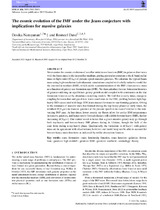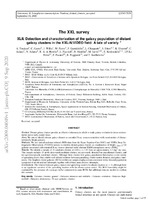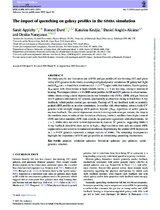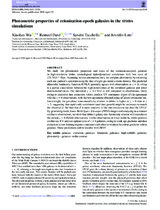| dc.contributor.author | Narayanan, Desika | |
| dc.contributor.author | Dave, Romeel | |
| dc.date.accessioned | 2017-07-24T07:55:09Z | |
| dc.date.available | 2017-07-24T07:55:09Z | |
| dc.date.issued | 2013 | |
| dc.identifier.citation | Narayanan, D. & Dave, R. (2013). The cosmic evolution of the IMF under the Jeans conjecture with implications for massive galaxies. Monthly Notices of the Royal Astronomical Society, 436: 2892–2906 | en_US |
| dc.identifier.issn | 0035-8711 | |
| dc.identifier.uri | http://hdl.handle.net/10566/3096 | |
| dc.description.abstract | We examine the cosmic evolution of a stellar initial mass function (IMF) in galaxies that varies
with the Jeans mass in the interstellar medium, paying particular attention to the K-band stellar
mass-to-light ratio (M/LK) of present-epoch massive galaxies. We calculate the typical Jeans
mass using high-resolution hydrodynamic simulations coupled with a fully radiative model for
the interstellar medium (ISM), which yields a parametrization of the IMF characteristic mass
as a function of galaxy star formation rate (SFR).We then calculate the star formation histories
of galaxies utilizing an equilibrium galaxy growth model coupled with constraints on the star
formation histories set by abundance matching models. We find that at early times, energetic
coupling between dust and gas drives warm conditions in the ISM, yielding bottom-light/topheavy
IMFs associated with large ISM Jeans masses for massive star-forming galaxies. Owing
to the remnants of massive stars that formed during the top-heavy phases at early times, the
resultant M/LK(σ) in massive galaxies at the present epoch is increased relative to the nonvarying
IMF case. At late times, lower cosmic ray fluxes allow for cooler ISM temperatures
in massive galaxies, and hence newly formed clusters will exhibit bottom-heavy IMFs, further
increasing M/LK(σ). Our central result is hence that a given massive galaxy may go through
both top-heavy and bottom-heavy IMF phases during its lifetime, though the bulk of the
stars form during a top-heavy phase. Qualitatively, the variations in M/LK(σ) with galaxy
mass are in agreement with observations; however, our model may not be able to account for
bottom-heavy mass functions as indicated by stellar absorption features. | en_US |
| dc.language.iso | en | en_US |
| dc.publisher | Oxford University Press | en_US |
| dc.rights | Publisher retains copyright. Authors may archive the published version in their institutional repository. | |
| dc.source.uri | http://dx.doi.org/10.1093/mnras/stt1548 | |
| dc.subject | Stars | en_US |
| dc.subject | Formation – stars | en_US |
| dc.subject | Luminosity function | en_US |
| dc.subject | Mass function – galaxies | en_US |
| dc.subject | Formation – galaxies | en_US |
| dc.subject | High-redshift – galaxies | en_US |
| dc.subject | ISM– galaxies | en_US |
| dc.subject | Starburst – cosmology | en_US |
| dc.subject | Theory | en_US |
| dc.title | The cosmic evolution of the IMF under the Jeans conjecture with implications for massive galaxies | en_US |
| dc.type | Article | en_US |
| dc.description.accreditation | Department of HE and Training approved list | |




